[/caption]
Try not to plummet off a steep crater cliff or be buried under a landslide while gazing at the irresistibly alluring curves of beautiful Rheasilvia – the mythical mother of Romulus and Remus – whose found a new home at the South Pole of the giant Asteroid Vesta.
3 D is undoubtedly the best way to maximize your pleasure. So whip out your cool red-cyan anaglyph glasses to enhance your viewing experience of Rheasilvia, the Snowman and more – and maximize your enjoyment of this new 3 D collection showcasing the heavily cratered, pockmarked, mountainous and groovy terrain replete at Vesta.
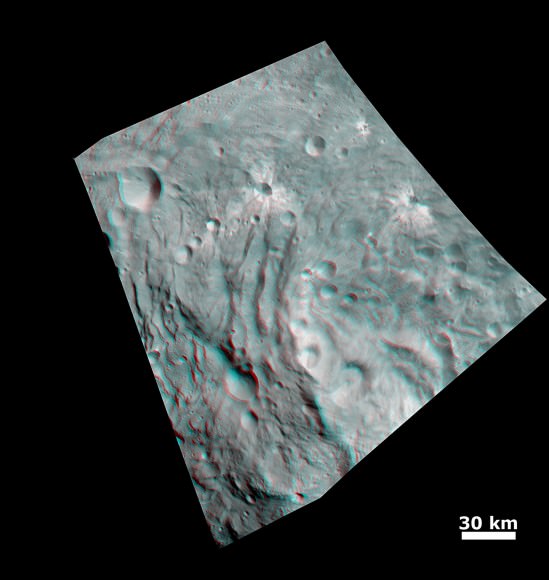
This image was obtained by NASA’s Dawn spacecraft from an orbit of about 1,700 miles (2,700 kilometers) above the surface of the giant asteroid Vesta. Topography in the area surrounding Vesta's south pole area shows impact craters, ridges and grooves. These images in 3D provide scientists with a realistic impression of the solid surface of the celestial body.
Credit: NASA/JPL-Caltech/UCLA/MPS/DLR/IDA
Can you find the location of the 3 D image above in the 2 D South Pole image below?
Scientists and mortals have been fascinated by the enormous impact crater Rheasilvia and central mountain unveiled in detail by NASA’s Dawn Asteroid Orbiter recently arrived at Vesta, the 2nd most massive object in the main asteroid belt. Ceres is the largest object and will be Dawn’s next orbital target in 2015 after departing Vesta in 2012.
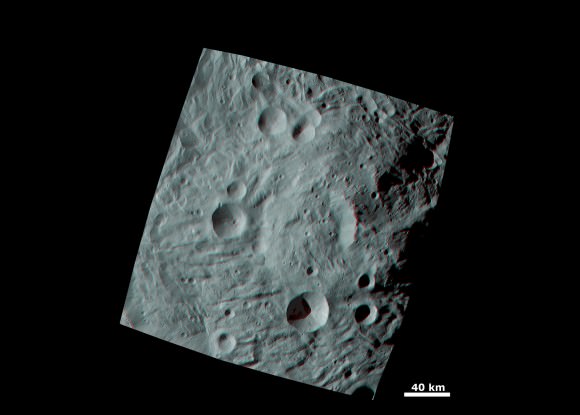
Scientists were fascinated by this enormous mound inside a big circular depression at the south pole- dubbed Rheasilvia. This stereo image was recorded from an altitude of about 1,700 miles (2,700 kilometers) above the surface and shows the structure of the mountain, displayed in the right half of this 3D image. The base of the mountain has a diameter of about 125 miles (200 kilometers), and its altitude above the surroundings is about 9 miles (15 kilometers). The vicinity of the peak of the mountain shows landslides that occurred when material from the flanks of the mountain were slipping down. Also visible are tectonic structures from tension in Vesta's crust. Credit: NASA/JPL-Caltech/UCLA/MPS/DLR/IDA
“Vesta is the smallest terrestrial planet in our Solar System”, said Chris Russell in an interview with Universe Today. “We do not have a good analog to Vesta anywhere else in the Solar System.”
And the best is yet to come. In a few days, Dawn begins snapping images from a much lower altitude at the HAMO mapping orbit of ca. 685 km vs the initial survey orbit of ca, 2700 km. where most of these images were taken.
Can you find the location of the 3 D South Pole images above in the 2 D South Pole image below?
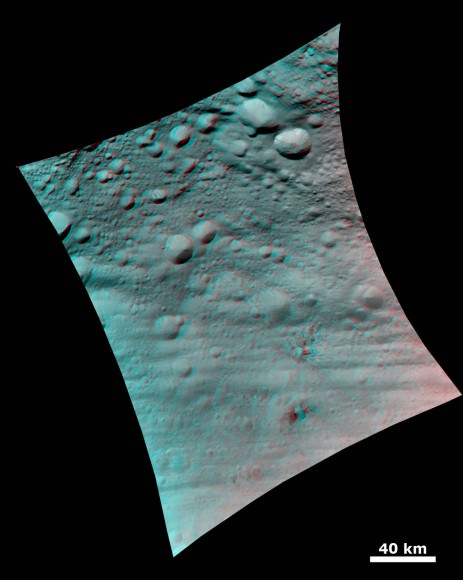
This 3 D anaglyph image shows the topography of Vesta's densely cratered terrain obtained by the framing camera instrument aboard NASA's Dawn spacecraft on August 6, 2011. Credit: NASA/JPL-Caltech/UCLA/MPS/DLR/IDA
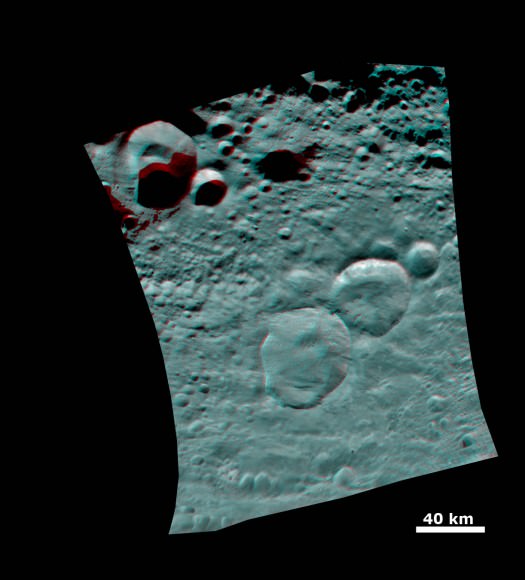
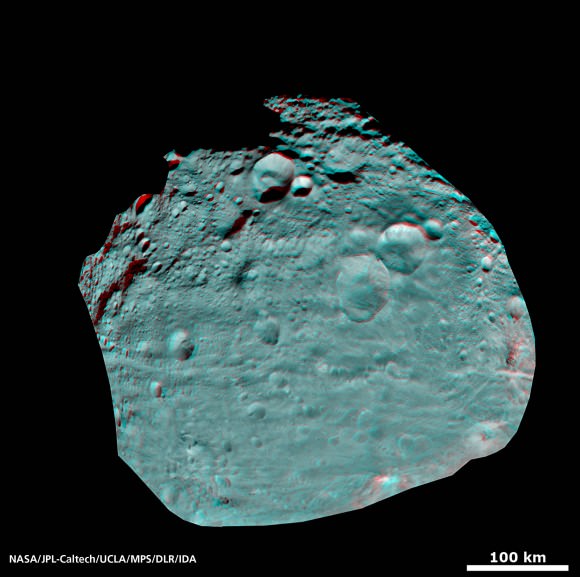
This image of the giant asteroid Vesta obtained by NASA's Dawn spacecraft shows the surface of the asteroid from an orbit of about 1,700 miles (2,700 kilometers) above the surface. Numerous impact craters illustrate the asteroid's violent youth. By counting craters on distinct geological surfaces scientists can deduce relative ages of the asteroid's surface. This 3D view provides scientists the opportunity to learn more about the morphology of craters on asteroids and physical properties of the material at Vesta's surface.. Image resolution is about 260 meters per pixel. Credit: NASA/JPL-Caltech/UCLA/MPS/DLR/IDA
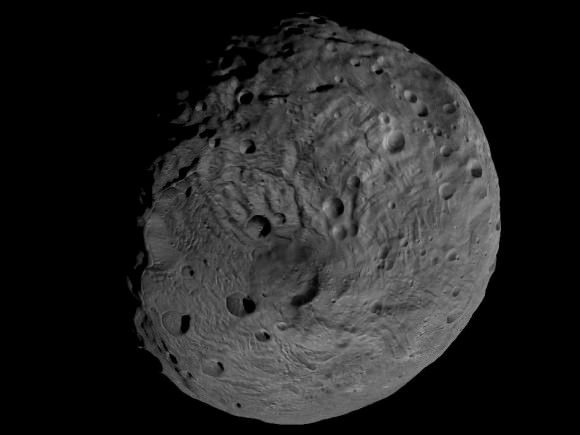
This image obtained by Dawns framing camera shows the south pole of the giant asteroid Vesta. Scientists are discussing whether the Rheasilvia circular structure that covers most of this image originated by a collision with another asteroid, or by internal processes early in the asteroid's history. Images in higher resolution from Dawn's next lowered orbit might help answer that question. The image was recorded from a distance of about 1,700 miles (2,700 kilometers). The image resolution is about 260 meters per pixel. Credit: NASA/JPL-Caltech/UCLA/MPS/DLR/IDA
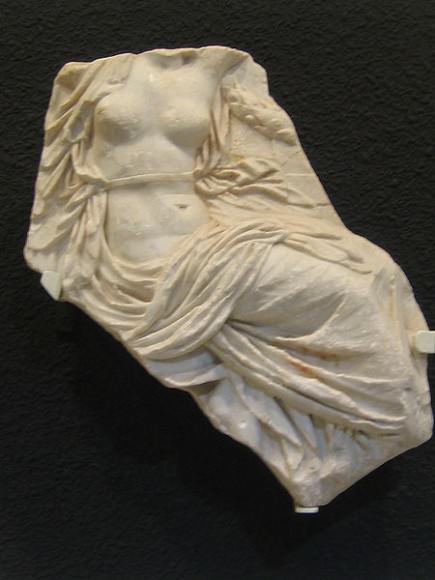
Read Ken’s continuing features about Dawn and Vesta
Rheasilvia – Super Mysterious South Pole Basin at Vesta
Space Spectacular — Rotation Movies of Vesta
3 D Alien Snowman Graces Vesta
NASA Unveils Thrilling First Full Frame Images of Vesta from Dawn
Dawn Spirals Down Closer to Vesta’s South Pole Impact Basin
First Ever Vesta Vistas from Orbit – in 2D and 3D
Dawn Exceeds Wildest Expectations as First Ever Spacecraft to Orbit a Protoplanet – Vesta
Dawn Closing in on Asteroid Vesta as Views Exceed Hubble
Dawn Begins Approach to Asteroid Vesta and Snaps First Images
Revolutionary Dawn Closing in on Asteroid Vesta with Opened Eyes

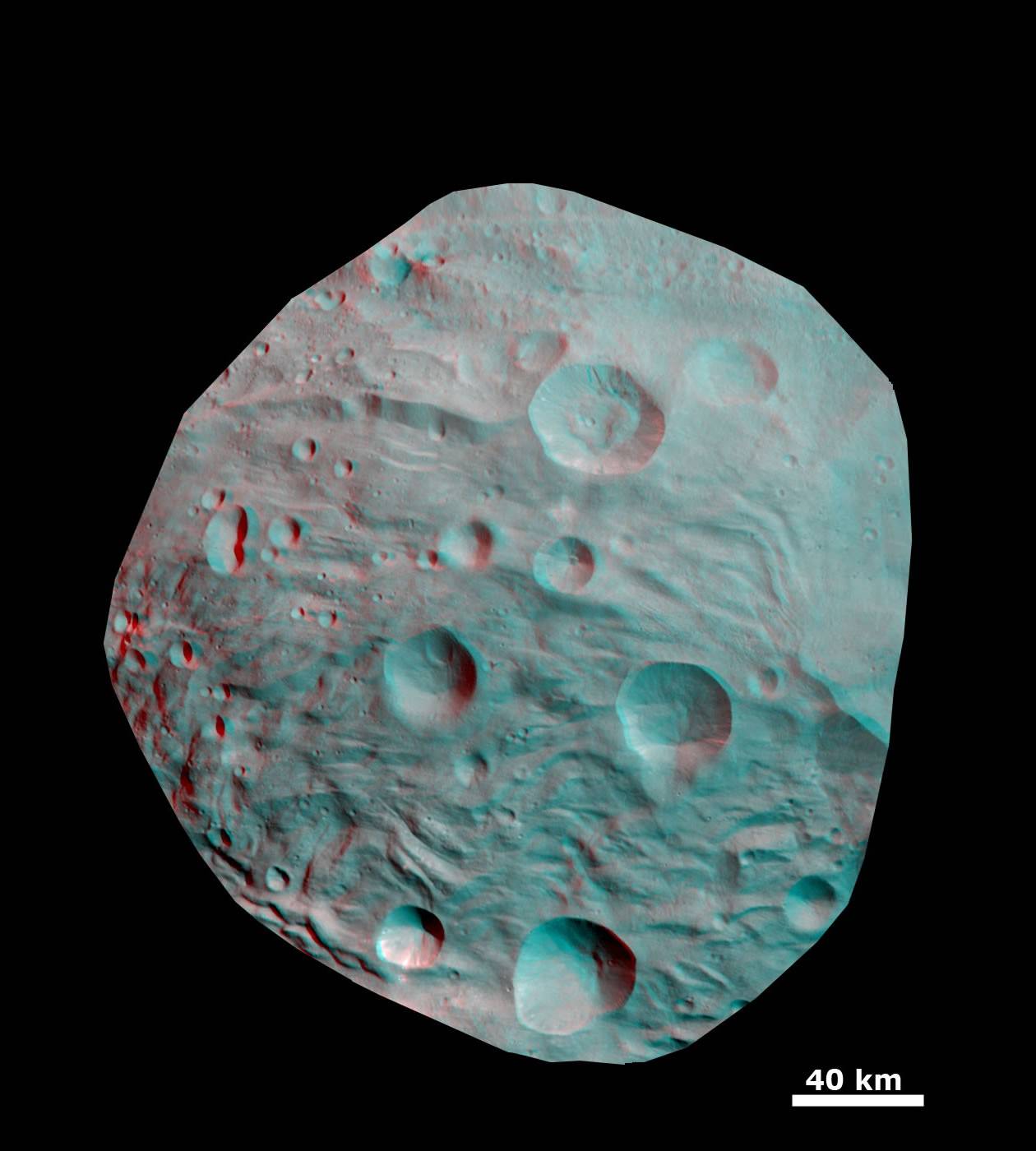
It looks so light in the 1st pic and so heavy in the last.
So, scientists are immortal?
I don’t have 3D glasses. Is it practical?
Maybe he means to say that scientists are not mere mortals but mortals with a big difference, like the fact that they help Nature reveal its hidden workings, which unconsciously turns them into something like seers/ mediums/channels channelling messages from the Beyond, with information taken from the Archives of Nature, otherwise known as the Akashic Records.
It reminds me of Hillary Clinton getting mad over a question at a news conference and shouting back, “I don’t channel my husband!”, because a scientist reading this will get mad and feel like screaming, “I don’t channel gods!”
3-D glasses make you see undulations of the terrain that you can’t otherwise see and it’s amusing. If you don’t have them all you have to do is cut out a card-paper frame and put a piece of transparent red plastic or some similar material on one of the openings and a blue one on the other one. It won’t take you more than a few minutes.
I don’t understand why they now say “cyan” instead of “blue”. If there’s a difference then it’s so subtle as to require a scientific explanation or a séance.
Or if they discover something important they become “eternal”.
She channels through Bill’s vibrator that he bought her. I like democrats, but she is an old type politician and should go…
Look at the first pic, there is a red colour in dark areas and I’d say green in lighter. Must be somehow connected. (green/blue or cyan)
What gives the impression of enhanced depth is not just the gross colored patches here and there but also a fine microstructure of red and bluish dots throughout that contributes to the sfumato effect invented by Leonardo da Vinci (the imperceptible blending of tones that make for a feeling of softness) because with the glasses on one can see an astonishingly warped surface all over, even far removed from those patches that seem like clumsy blotches.
Also, the term “anaglyph” is misleading because it means “relief carving”, whereas the 3-D phenomenon suggests both relief and the opposite, namely, incised carving (“intaglio”), so they had better start looking for a better word.
Then there’s the odd fact, having nothing to do with the colors, that in some of the photos the craters look like blisters and in others like what they really are –depressions– but if you copy/paste them onto a Word document and use the tool allowing one to rotate an image and place it upside down the blisters turn into depressions and vice versa (depressions become mounds). Is everybody aware of this by now? A long time ago I read about it and I no longer remember whether or not they gave an explanation or if it remains unexplained. In those days there was no Internet and no PC’s but all one had to do was turn the magazine around.
I think the NASA furnishes a pattern for the glasses that one can download and print out.
Yes, Democrats have the endearing quality of sounding generous, fair and compassionate (and she’s cute, too), but things are not what they seem to be, as pointed out by Columbia U. economist Ferdinand Lundberg: both sides get their campaigns financed by Big Business and they legislate accordingly, sometimes to the point of establishing laws that will benefit a single individual.
Sorry about being so down-to-earth. We’re supposed to be discussing heavenly matters here….